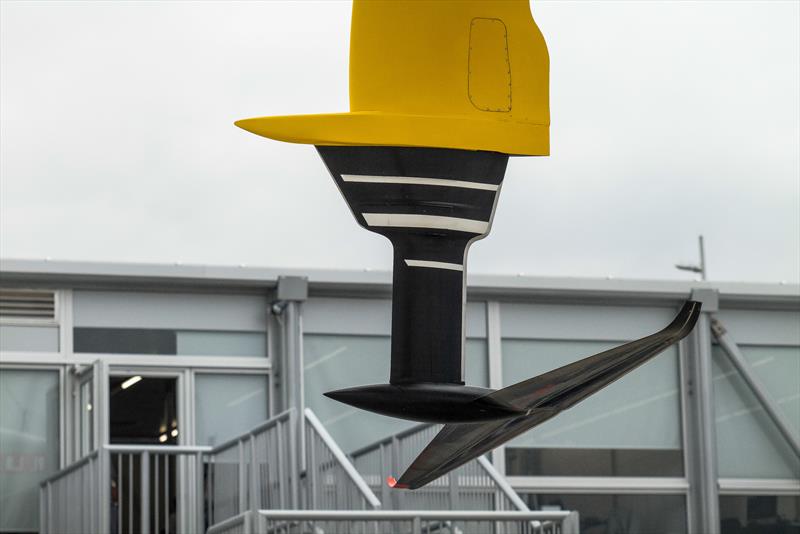
Cup Spy: Kiwis run with Italian wing foil spike design idea
by Richard Gladwell Sail-World NZ 30 Jun 2024 06:57 BST

Foil arm spike and standard foil arm fairing - Luna Rossa - AC75 - Day 27 - June 14, 2024 - Barcelona © Alex Carabi / America's Cup
Emirates Team New Zealand appear to have followed the lead of rival Luna Rossa Prada Pirelli with their first reveal of wing foils that comply with Version 2 of the AC75 Class Rule that will be operative for the upcoming America's Cup in Barcelona.
The Kiwis launched their AC75 yesterday in Barcelona with new generation foils - which are quite different from the 2021 America's Cup "legacy" foils they used in Auckland on their new AC75 raceboat.
The most obvious feature borrowed from the Italian design team is the forward facing spike at the point where the custom design wing foil attaches to the one design foil arm, which is a supplied part and has not changed since the 2021 America's Cup.
The Foil spike, whose purpose has not been revealed by the Italians usually flies just above the surface of the water cleaning up the interface between the wing foil and the water surface as it cuts through at speeds in excess of 50kts. It is not permitted to add weight to the foil arm stock, however broadly speaking what happens below the foil arm stock is over to the designers.
Depending on its construction material, the wing foil spike may also be a neat way of shifting weight out of the foil bulb - where it will make less drag and into an area of the foil that passes through the air.
That in turn allows a more streamlined bulb. There is some difference in the Italian bulb which is more pointed, while the Kiwi wingfoil bulb has a blunter more rounded nose and entry.
Cup Spy's guess is that the function of the crudely shaped foil spike is that of a corrector weight to bring the wing foil up to the optimal weight for performance within the range specified in the Class Rule. The corrector weight allows other underwater shapes in the wingfoil to be optimised for drag and efficiency, without having to worry too much about the weight impact of the part - which can be absorbed into the corrector.
A closer look at the only foil arm shot, provided by Emirates Team New Zealand of the AC75 before launch, shows that the standard fairing around the lower aft edge of the supplied foil arm has been removed completely. This is the first time this approach has been adopted by any team in this, or the last America's Cup.
The effect is for the tailing edge of the foil arm, is that it is completely straight in the supposed one design section on the Version 2 wingfoil on the ETNZ AC75 raceboat. The fairing is present to some degree on the other AC75s (seen on Luna Rossa, American Magic, Alinghi Red Bull Racing and INEOS Britannia and the ETNZ legacy foil in the images below).
The only foil arm shot provided by Emirates Team New Zealand of the AC75 before launch shows that the standard fairing around the lower aft edge of the supplied foil arm has been removed completely. This is the first time this approach has been adopted by any team in this, or the last America's Cup.
The rules governing foil arms, split the device into two components - the stock - which cannot be altered in any way except for minor matters such as sanding. The second part is the Foil Arm Fairing which has a lot of design latitude - however the Kiwis appear to have treated as allowing its near complete removal, without altering the supplied foil arm stock.
Without the work of the AC37 Joint Recon team, we're unlikely to see too many images of the Kiwi foils, or get comment on the purpose of the wingfoil spike.
From the earlier reconnaissance images taken of the Italian AC75 raceboat it is not possible to accurately compare the actual wing shapes of the two design teams. However from the single available image, expanded from a larger image taken by ETNZ at the AC75 launch in Barcelona, it would seem that they are similar in shape.
The New Zealand boat was launched in Barcelona with new wing foils and maybe rudder. Thanks to the AC37 Joint Reconnaissance program, the Recon team assigned to each Challenger and Defender were allowed access to the team base and could take very accurate photos and video of the Version 2 AC 75 yachts as they were revealed. However with Emirates Team New Zealand not being revealed until a week after the AC37 Joint Recon program has ended, the other teams will be denied the same detailed view and opportunity using photogrammetry to develop a 3-D view of the new components.
Instead the rival teams will be forced to resort to a longer range approach using chase boats, or powerful camera lens from a shore based vantage point as the New Zealand AC75 is launched.